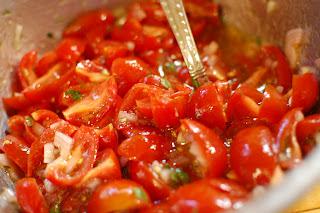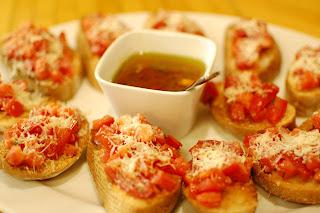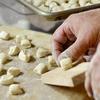Raw, dried or preserved fruit or vegetables are soaked in a liquid to soften and rehydrate the food or absorb the flavor of the liquid into the food. Maceration is also the chief means of producing a flavored alcoholic beverage, such as cordials and liqueurs.
 Maceration is often confused with marination, which is the process of soaking foods in an acidic liquid before cooking. Maceration is the process of soaking produce in liquid for extra flavor.
Maceration is often confused with marination, which is the process of soaking foods in an acidic liquid before cooking. Maceration is the process of soaking produce in liquid for extra flavor.During the summer months, we frequently enjoy a salad of macerated tomatoes with garlic and fresh herbs served with crusty bread; this salad is commonly referred to as bruschetta. This is a marvelous accompaniment to almost any dish especially fish, and regularly serves as the entire meal on particularly hot, muggy evenings.
6 or 7 ripe plum tomatoes (about 1 1/2 lbs), diced
2 cloves garlic, minced
1 tablespoon extra-virgin olive oil
1 teaspoon Kosher salt
1-2 tablespoons fresh herbs (basil, oregano, tarragon, marjoram and/or thyme), chopped
Freshly ground black pepper to taste
French bread or similar Italian bread
 Cut tomatoes in halves or quarters depending on their size, removing the stem area as you go. If plum tomatoes are not available you can use any fresh ripe tomatoes and chop into ½” cubes. Place tomatoes in a serving bowl and add garlic, salt and herbs, stirring to mix well. Let the salad sit for at least 30 minutes before serving so tomatoes fully release their juices. Serve with bread and a good red wine and experience the true taste of summer.
Cut tomatoes in halves or quarters depending on their size, removing the stem area as you go. If plum tomatoes are not available you can use any fresh ripe tomatoes and chop into ½” cubes. Place tomatoes in a serving bowl and add garlic, salt and herbs, stirring to mix well. Let the salad sit for at least 30 minutes before serving so tomatoes fully release their juices. Serve with bread and a good red wine and experience the true taste of summer.
